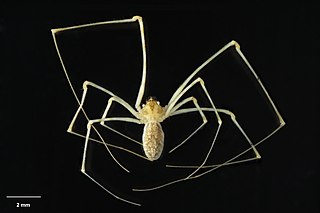Runga is a genus of Polynesian araneomorph spiders in the family Physoglenidae that was first described by Raymond Robert Forster in 1990.

Meringa is a genus of araneomorph spiders in the family Physoglenidae that is endemic to New Zealand. It was first described by Raymond Robert Forster in 1990. Originally placed with the Synotaxidae, it was moved to the Physoglenidae in 2017.

Nomaua is a genus of Polynesian araneomorph spiders in the family Physoglenidae that was first described by Raymond Robert Forster in 1990. Originally placed with the Linyphiidae, it was moved to the Synotaxidae in 1990, and is now considered a senior synonym of Wairua.

Pahora is a genus of Polynesian araneomorph spiders in the family Physoglenidae that was first described by Raymond Robert Forster in 1990. Originally placed with the Synotaxidae, it was moved to the Physoglenidae in 2017.

Pahoroides is a genus of Polynesian araneomorph spiders in the family Physoglenidae that was first described by Raymond Robert Forster in 1990.
Paratupua is a monotypic genus of araneomorph spiders in the family Physoglenidae found in Victoria, Australia. It contains the single species, Paratupua grayi. Though it's sometimes misspelled Paratupa, the correct spelling is "Paratupua".

Physoglenidae is a family of araneomorph spiders first described by Alexander Petrunkevitch in 1928 as a subfamily of Pholcidae. It was later moved to Synotaxidae until a study in 2016 showed that they formed a distinct clade.
Mangua caswell is a species of Physoglenidae spider endemic to New Zealand.
Mangua convoluta is a species of Physoglenidae spider endemic to New Zealand.
Mangua flora is a species of Physoglenidae spider endemic to New Zealand.
Mangua forsteri is a species of Physoglenidae spider endemic to New Zealand.
Mangua gunni is a species of Physoglenidae spider endemic to New Zealand.
Mangua hughsoni is a species of Physoglenidae spider endemic to New Zealand.
Mangua kapiti is a species of Physoglenidae spider endemic to New Zealand.
Mangua makarora is a species of Physoglenidae spider endemic to New Zealand.
Mangua medialis is a species of Physoglenidae spider endemic to New Zealand.
Mangua oparara is a species of Physoglenidae spider endemic to New Zealand.
Mangua otira is a species of Physoglenidae spider endemic to New Zealand.
Mangua paringa is a species of Physoglenidae spider endemic to New Zealand.
Mangua secunda is a species of Physoglenidae spider endemic to New Zealand.




